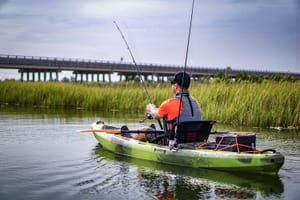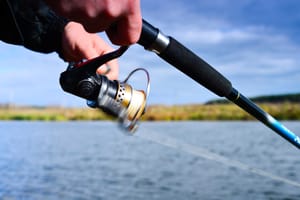Walleye fishing is an art that combines skill, patience, and the right equipment. One crucial aspect of the equipment is the reel, and more specifically, the gear ratio of the reel. This article will delve into the intricacies of choosing the best gear ratio for a walleye reel, ensuring you have the knowledge to make an informed decision for your next fishing adventure.
Key Takeaways:
- Understanding gear ratios is crucial for selecting the best walleye reel.
- The ideal gear ratio for walleye fishing depends on various factors, including fishing technique and water conditions.
- A balanced gear ratio offers versatility for different walleye fishing scenarios.
Understanding Gear Ratios
Before we dive into the specifics for walleye reels, it's important to understand what a gear ratio is. The gear ratio of a fishing reel refers to the number of times the bail rotates around the spool with a single turn of the reel handle. For example, a 5.2:1 gear ratio means that for every turn of the handle, the bail goes around the spool 5.2 times. This ratio plays a significant role in determining the reel's performance for various fishing techniques.
The Significance of Gear Ratio in Walleye Fishing
When targeting walleye, the gear ratio can affect your ability to present baits effectively and respond to the subtle bites this species is known for. A higher gear ratio reel retrieves line faster, which is great for quick retrieves, while a lower gear ratio offers more power for pulling in larger fish or fishing in strong currents.
The Ideal Gear Ratio for Jigging
Jigging is a popular technique for catching walleye, and it requires a reel that allows for precise control and sensitivity. A moderate gear ratio, such as a 5.0:1 to 6.0:1, is often recommended for jigging. This range provides a good balance between retrieval speed and torque, allowing anglers to feel the bite and set the hook effectively.
Trolling for Walleye: Gear Ratio Considerations
Trolling is another effective method for catching walleye, and it typically requires a different gear ratio. For trolling, a lower gear ratio, such as 4.0:1 to 5.0:1, is often preferred. This slower retrieval rate gives you the power needed to pull in walleye, especially when they're hooked on deep-diving crankbaits or when fighting against the resistance of a planer board.
Spinning vs. Baitcasting Reels for Walleye
The type of reel you choose, spinning or baitcasting, will also influence the ideal gear ratio. Spinning reels are user-friendly and work well with lighter lines and lures, making them suitable for finesse techniques. Baitcasting reels offer more control and are better for heavier lines and lures, as well as for precision casting.
Seasonal Variations and Gear Ratio
Walleye behavior changes with the seasons, which can affect the appropriate gear ratio. In colder water, walleye are less active, and a slower gear ratio can be more effective. Conversely, in warmer water, when walleye are more aggressive, a faster gear ratio may be beneficial to keep up with the active fish.
The Role of Water Conditions
Water conditions, such as clarity and current, can also dictate the best gear ratio for walleye fishing. In murky or turbulent waters, a reel with more torque (lower gear ratio) can give you better control. In clear and calm waters, a higher gear ratio can be advantageous for quick retrieves and covering more water.
Personal Preference and Experience
Ultimately, the best gear ratio for a walleye reel can also come down to personal preference and experience. Some anglers may prefer a faster or slower retrieve based on their fishing style. It's important to experiment with different gear ratios to find what works best for you.
Balancing Speed and Power
A balanced gear ratio is often the key to versatile walleye fishing. A ratio that offers a compromise between speed and power can adapt to various techniques and conditions. A gear ratio around 5.5:1 is considered a good all-around choice for many walleye anglers.
The Impact of Line Capacity and Retrieve Rate
While the gear ratio is important, it's also essential to consider the line capacity and the actual retrieve rate of the reel. A reel with a high gear ratio but a small spool may not retrieve line as quickly as a larger spool with a lower gear ratio. It's important to look at the inches-per-turn (IPT) rate to get a true sense of the reel's retrieval speed.
Summary
Choosing the best gear ratio for a walleye reel is about finding the right balance for your fishing technique, the conditions, and your personal preferences. While there is no one-size-fits-all answer, a moderate to slightly high gear ratio, such as 5.0:1 to 6.0:1, is a versatile choice that can handle a variety of walleye fishing scenarios. Remember to consider the type of reel, the season, and the water conditions when making your selection. With the right gear ratio, you'll be well-equipped to reel in those elusive walleye. Maximize your walleye fishing success by exploring our Best Spinning Reel for Walleye | Amazing Top 5 for 2024, complete with a comprehensive buyer's guide to help you make the perfect choice!
FAQ Section
Can I use the same gear ratio for both jigging and trolling for walleye?
While you can use the same gear ratio for both techniques, it may not be optimal. Jigging often requires a moderate gear ratio for control and sensitivity, while trolling can benefit from a lower gear ratio for power. However, a balanced gear ratio around 5.5:1 can be a good compromise for both techniques.
How does the gear ratio affect the fight with a walleye?
The gear ratio can influence the amount of power and speed you have during the fight. A lower gear ratio provides more cranking power for pulling in larger fish or fighting against strong currents, while a higher gear ratio allows for faster line retrieval, which can be useful for keeping tension on the line and quickly reeling in active fish.
Should I prioritize gear ratio over other reel features when targeting walleye?
While the gear ratio is an important factor, it should not be the only feature you consider. The overall quality of the reel, the drag system, line capacity, and the type of reel (spinning vs. baitcasting) are also crucial elements that contribute to successful walleye fishing. It's best to find a reel that offers a good combination of all these features.



